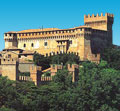Gradara's Castle and the legend of Paolo and Francesca
Beaches
Fun and Nightlife
Visit Cattolica
- The history of Cattolica and its traditions
- The town hall
- The dancing fountains of 1° Maggio square
- The town centre
- The historical centre
- The Regina museum
- The Market square
- The multi-cultural centre
- The Regina theatre
- The churches
- The walk along via Dante
- The beach and the sea front
- The harbour
- The water park "Le Navi"
Inland
Search on cattolica hotel
Gradara, the town of Paolo and Francesca

Gradara between art and history
At 142 metres above sea level, with the Republic of (San Marino) and Carpegna in the background,rises
Gradara theatre of the tragic love story of Paolo and
Francesca, mentioned by Dante, Petrarca, Boccaccio and D'Annunzio. The first construction dates back to 1150,
the Castrum Cretarie independent from Pesaro. Following this, the Malatesta, after buying it, transformed the
tower into a Rocca incorporating it into two tall and towered city walls. In 1464 their dominion which had
transformed Gradara into an "Embellished villa with superb buildings, pleasant plantations and ample
vineyards" came to an end. Then began the era of the Sforzas which gave the Rocca and all-round
rinascimental appearance: the massive stair case, the open gallery, the Pala of Andrea Della Robbia and the
frescoed room, amongst which gave the small room of Lucrezia Borgia when she lived there for the three years
of her marriage to Giovanni Sforza. With the premature death of young Costanzo, and shortly after the death
of Giovanni, the Sforza dynasty ceased, and in 1513 Francesco Maria Della Rovere, nephew of Pope Giulio II
came on the scene. In 1631 the Rocca, along with the Dukedom of Pesaro and Urbino became part of the
Papal State. These were the years of decay with French Pillages, and finally culminating with the earthquake
of 1916. The engineer Zanvettori in 1920 bought the fortress and destined it to a comprehensive restoration
which would last for three years. His wife Alberta Porta Natale, after the death of har husband, chose
Gradara as her pleasant retreat in the summer and the spring. On her death in 1983 the fortress become
property of the state.

The legend of Paolo and Francesca
"Love, that allows no loved one to be excused from loving..." whispers Francesca seduced by the
beautiful aspect of Paolo and abandoning herself to the love passion that will lead her to a tragic end.
Around the end of 1200 the Old Mastin, lord of Romagna reinforced his political alliance with Guido Minore da
Polenta, lord of Ravenna with the marriage of their respective children, Francesca da Polenta and Giovanni
Malatesta, said "The Lame". Giovanni was then lord of Pesaro, Gradara was therefore the closest and
most secure place to host the young bride. Francesca often alone in her castle must have with no doubt
enjoyed the visits of the handsome Paolo, whom she falls hopelessly in love with. "But one day we read,
to our delight, of Lancelot and how love constrained him... That book was a Galeotto, a pandar and he who
wrote it, that day we read no more". A story that Dante told first and which has also inspired various
poets and artists of all times. Today still, when the "Seduction at the Castle" manifestation
takes place, in the Middle Age fortress avery third weekend of July, are lived again the moments of the
romantic atmosphere in memory of those who loved each other so much in this place. Magic middle age
suggestions, melodies of minstrels, dances of young ladies, poetic verses to remember that forbidden kiss
which still seduces lovers.
Video
Links
Weather Forecast

Want to know the weather forecast in the coming days?
Visit the weather section.
Sponsor Hotels
 Deutsch
Deutsch English
English
 Francais
Francais Italiano
Italiano




